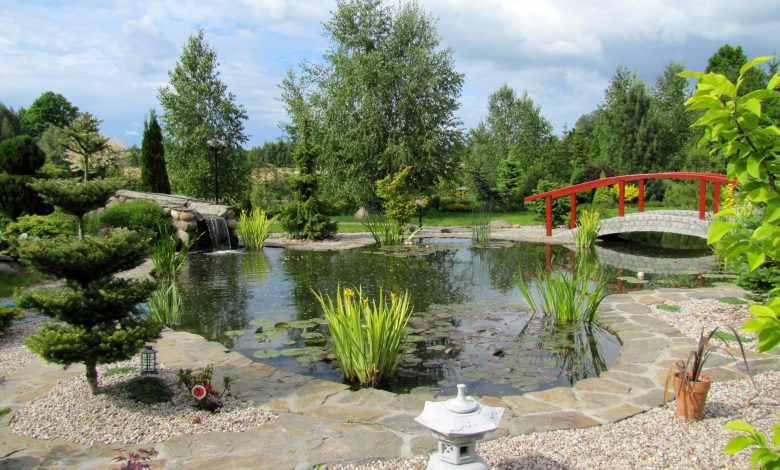How to Create a Zen Garden

One of the emerging trends in garden design this decade has incorporated the ability to make a space that is as relaxing as possible. In the busy world we live in, it’s no surprise that people are searching for a place where they can unwind and refresh themselves without judgement.
That being said, the rise of the Zen garden has begun. A Zen garden is essentially a green space where there is little upkeep and conscious design choices. For anyone with a green thumb, this kind of garden might be an interesting challenge to create. As opposed to the approach of a ‘wild and free’ garden, this style is more contained and intentional.
If you’re looking for a green space where you can find peace and quiet, consider learning how to create a Zen garden. It’s like having a living, growing spa in your own backyard!
What is a Zen Garden?
The humble beginnings of the Zen garden started in Japan, where Buddhist monks came up with the basic design. The monks have a high respect for the natural land, and wanted to incorporate its raw beauty into their man-made gardens.
These “miniature landscapes” as they’re known, are symbols of the natural aspects that are seen in Japan. The small gravel pieces are raked to represent the waves of the ocean, while the larger boulders signify mountains.
Smaller, flatter stones are said to represent the islands that are scattered around the ocean. When it comes to greenery, smaller plants can represent vegetation on the islands, while trees and larger plants can take the place of the larger boulders.
These basic features of the Zen garden have been evolving over centuries, especially since the style has spread across the world. People have made their Zen gardens their own, altering the basic aspects and incorporating other elements.
That being said, there isn’t a set list of components you need to create your Zen garden. If there are features that you find attractive or designs you find soothing, these will work best.

The Basics of a Zen Garden
There are a few things that characterize the Zen garden and set it apart from the rest. These characteristics are what give this type of garden a more modern feel, and certainly a more contained décor.
Minimalism
One of the key components of a Zen garden is minimalism. To create a Zen garden, you have to be okay with fewer items in your garden; those who prefer all kind of fun hanging pieces and wall décor often struggle with this kind of design.
Even though it lacks lots of pieces, this isn’t to say that the Zen garden is boring! Rather, the decorations that are used are intentional, and each has their own specific purpose. Anything that is in this garden simply for added fluff won’t do.
The decorations implemented in this type of garden have various textures and colors, and this is what allows for the garden to still be aesthetically pleasing and interesting. Less is more in this case.
Manicured
Green thumbs who like to grow an organized garden will certainly appreciate this part of the Zen garden. Everything in this space needs to be manicured and clean, as opposed to having plants that are overgrown and taking over a space.
A lot of the plants used in Zen gardens only require some trimming, but they are not the type that re-seed and get out of control. That being said, this garden often features lots of potted plants that stay in one space.
Easy
If you’re just beginning to grow a Zen garden, you might feel like it’s a lot of work. Planning the garden certainly takes time, and finding the ideal plants and stones will take time, too.
That being said, once your Zen garden is complete, it can be one of the easier styles to maintain over time. That’s because of the types of plants that work in these gardens and the little maintenance that your design should require.
For anyone who wants to enjoy a green space that is simpler to take care of, a Zen garden can be a great option.
Bright
Like most gardens, Zen gardens are filled with bright light, whether that be natural sunlight or artificial. Not all of these gardens are grown outdoors; interestingly, many are actually found indoors!
Because of their controlled growth and cleanliness, it is possible to create a Zen garden inside. Lots of companies implement these designs into their offices in order to offer a relaxing space for their employees. In these cases, artificial light ensures that the space is bright and the plants can still flourish.
Intimate
Growing a Zen garden is possible in any space; however, this kind of style is mostly created in more intimate spaces. Even though it’s more than acceptable to create a large Zen space, these types of gardens are best enjoyed when they’re in smaller spaces.
If you have a larger yard, you can always square off a smaller space and dedicate it to your Zen design. Alternatively, if you have a small backyard, you can dedicate the entire space to this style. Whatever makes you feel the most relaxed is best; a larger garden simply requires more work.

Best Plants for a Zen Garden
Your Zen garden is your own to design, but there are some plants that do best in this type of garden. This is often because of the shape and size of the plants, as well as their behavior once planted.
Moss
Moss does well in Zen gardens, especially when it acts as ground cushion. Moss is easy to control and contain and looks amazing when it starts to creep over rocks and tiling. If you like a comfortable space for your bare feet, moss or similar plants, are ideal.
Bamboo
Bamboo is a very hardy grass, which can be used for a variety of things in your Zen garden. One of the best uses is for privacy, since bamboo is strong and ideal for fencing. In addition, bamboo can also help to reduce noise, which is key to truly enjoying your garden.
Creeping Junipers
Creeping junipers are great for ground cover, and they also help to discourage weed growth. Their bright green colors are a welcome addition to Zen gardens, and there’s no need to mow them like you would regular grass.
Their low-maintenance and thick cover are ideal for creating a cushioned space in a Zen space.
Silk Trees
Silk trees grow a beautiful, cone-shaped flower that is impossible to ignore. Gardeners will love that these trees have no problems with disease or insects, and they can tolerate a wide range of conditions regardless of where they’re located.
Silk trees can grow in rural or urban areas, which means they will do well regardless of the location of your Zen garden.
Creeping Thyme
You can definitely add some flowering plants to a Zen garden, and Creeping Thyme is a great option. Not only does this type of plant come in a range of bright colors, it also gives off an amazing aromatic smell.
Additionally, you can use Creeping Thyme for groundcover, as well as to stifle any weeds. If you want any creeping plants between your stepping stones, this plant is a great option.
Japanese Maples
Japanese Maples provide beautiful changing colors to a garden, ranging from dark greens in the spring, to bright, vibrant reds in the fall.
They can survive various weather patterns if protected properly, so they do well in both cold and warm climates. Japanese Maples come in a range of sizes, so you can choose a low-lying version to add some shape to your garden or a large maple that will grow straight and tall.

Key Features of a Zen Garden
Before you go ahead with building a Zen garden, you’ll want to make a plan. Once you’ve laid down your initial groundcover and chosen specific paths, it will be a lot of work if you happen to change your mind.
Here are the key features of a Zen garden to consider:
Entrance
A Zen garden should be designed to remove you from the outside world. That being said, this kind of space should be on its own with an attractive gate or door for entry.
Raked Gravel
As mentioned previously, raked gravel has been a symbol for the flowing waves in Japanese gardens. Most Zen gardens implement some type of gravel space, which is kept flat and patterned with a rake.
You can choose the color that works for you and litter the area with stepping stones to keep the gravel in place.
Water Element
The sound of water can be very calming to a garden-goer, and depending on the size of your space, you can implement as much or as little as you want.
Some gardeners choose to build a small pond for koi fish, while more elaborate garden designs will implement a large body of water that even has an island! A water element is ideal for a Zen garden, simply for the soothing properties and pleasing sounds.
What’s great about a water element is that gardeners can get very creative with the décor and plant life they surround the water with. Some ideas include bamboo fountains, Lily pads, smooth rocks, and moss.
Secrecy
Some of the more elaborate Zen gardens are not just comprised of an open-concept space. Rather, they elude to some mystery or secrecy by having hidden corners and trails that lead to unknown spaces.
This kind of mystery is a key component of traditional Zen gardens.
Pagoda Pillars
Pagoda pillars are a traditional sight in gardens all across Japan, but you can purchase these almost anywhere. These pillars are beautiful structures that can hold candles or lights that emit a gentle glow through your garden.
These are ideal if you want to enjoy your Zen garden through the evening. Of course, you can create a Zen garden that’s just as beautiful with smaller lanterns or solar lamps throughout the area.
Koi Fish
If you do implement a water feature into your Zen garden, you might consider filling it with some koi fish or goldfish. Koi fish are a signature animal in Japanese ponds, and they are very intelligent animals as well.
Keep in mind, these fish may need to have a suitable space indoors when winter comes around.
Colors
There are no set rules when it comes to the colors you implement in your garden. However, it has been said that cool colors, such as blues and greens, are the most relaxing shades.
Feel free to add pops of color with flowering plants, but keep in mind that green is the main color you should be seeking when growing your Zen garden.
Greenery
The best Zen gardens incorporate a great deal of greenery into the space. It has been said that being in nature helps us to feel more calm and relaxed, and so implementing greenery into your garden is important.
Another key feature of the Zen garden is combining a variety of colors and textures, and this can be achieved through the planting of a variety of different plants, trees, and shrubs.
A Structure
In order to fully enjoy your Zen garden throughout the warmer seasons, consider building a covered space. Here, you can set up a sitting area where you can entertain guests or simply sit in the quiet and enjoy the landscape.
In smaller spaces, you might need to get creative with how you create coverage. There is nothing quite like sitting in your garden during a light rainfall, so it’s worth it to create a structure where you can enjoy what you’ve built.
Seated Areas
If you can’t go forward with a structure, it’s always acceptable to implement some simpler areas for seating. Meditative pillows that work outdoors can be placed anywhere in the space, specifically in areas where you feel most at ease and able to meditate.
When you’re done, you can either leave the pillows, or bring them inside for next time. Consider having a few pillows ready, so guests can find their own spot to meditate as well.

How to Build a Zen Garden
Once you’ve got your main design and features planned out, you can start implementing them into your yard. Here are the main steps for how to create a Zen garden:
Decide on Your Space
Decide on a specific space for your garden, and rope this off to begin. If you’re not sure what shape to start with, a rectangle is usually an ideal shape.
Clear the Area
Begin by clearing this area completely. This means getting rid of plants, weeds, stones, grass, and gravel.
Remove the Top Layer
You’ll need to remove the top layer of the soil that has been exposed. You’ll only need to remove a few inches off the top.
Even Out the Layer
You’ll need the layer you’ve exposed to be as level as possible. This will ensure that your stones and pathways are even. You can use a string level to make sure every part of the area is balanced, as well as using a garden rake to flatten out higher areas.
Block Your Gravel
If you’re implementing gravel into the space, you’ll need something to keep the stones contained. Line your garden with stone edging so that you don’t have to worry about cleaning up runaway gravel.
Prepare Soil for Plants
Create deep holes where your plants, rocks, and pots are going to be placed. This is all subject to your own creativity!
If you’re not sure where to put what, you can always refer to actual maps for some guidance and inspiration. Lay down rocks where actual islands are, perhaps from your favorite place. Once you’ve created holes for all of your items, you can place your plants and rocks in their designated spots.
Lay Down Fabric
You can now lay down your landscape fabric. Cut holes to accommodate the plants and rocks you’ve already set in place. After the fabric is set, you can pour down your gravel or stones of choice.
From here, you’ll be able to get a feel for what else your garden needs, or where your stepping stones should naturally go. Use a rake to create a beautiful design in the gravel; if the weather disturbs your design, take the time to enjoy re-creating it again.

Taking Time for You
Life can get overwhelming, and we often seek spaces where we feel safe and serene. If you’re looking for a place to Zen out, look no further than all of the possibilities in your own backyard.
The best part about this kind of space is that you can create something beautiful, no matter how much or how little space you have. Choose décor that speaks to you and plants that you enjoy taking care of.
In no time at all, you will grow a Zen garden that you never want to leave!



